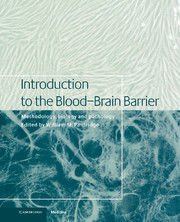Book contents
- Frontmatter
- Contents
- List of contributors
- 1 Blood–brain barrier methodology and biology
- Part I Methodology
- Part II Transport biology
- Part III General aspects of CNS transport
- Part IV Signal transduction/biochemical aspects
- 31 Regulation of brain endothelial cell tight junction permeability
- 32 Chemotherapy and chemosensitization
- 33 Lipid composition of brain microvessels
- 34 Brain microvessel antigens
- 35 Molecular dissection of tight junctions: occludin and ZO-1
- 36 Phosphatidylinositol pathways
- 37 Nitric oxide and endothelin at the blood–brain barrier
- 38 Role of intracellular calcium in regulation of brain endothelial permeability
- 39 Cytokines and the blood-brain barrier
- 40 Blood–brain barrier and monoamines, revisited
- Part V Pathophysiology in disease states
- Index
32 - Chemotherapy and chemosensitization
from Part IV - Signal transduction/biochemical aspects
Published online by Cambridge University Press: 10 December 2009
- Frontmatter
- Contents
- List of contributors
- 1 Blood–brain barrier methodology and biology
- Part I Methodology
- Part II Transport biology
- Part III General aspects of CNS transport
- Part IV Signal transduction/biochemical aspects
- 31 Regulation of brain endothelial cell tight junction permeability
- 32 Chemotherapy and chemosensitization
- 33 Lipid composition of brain microvessels
- 34 Brain microvessel antigens
- 35 Molecular dissection of tight junctions: occludin and ZO-1
- 36 Phosphatidylinositol pathways
- 37 Nitric oxide and endothelin at the blood–brain barrier
- 38 Role of intracellular calcium in regulation of brain endothelial permeability
- 39 Cytokines and the blood-brain barrier
- 40 Blood–brain barrier and monoamines, revisited
- Part V Pathophysiology in disease states
- Index
Summary
Chemotherapy for brain tumors
Brain tumors are the second and fourth leading causes of cancer mortality in children and in young adults between the age of 15 and 34 respectively. Clinical progress in the treatment of these malignancies has been slow. Surgery is difficult because tumor cells infiltrate into surrounding brain, making complete resection impossible. Physical localization of the tumor in deep cortex or in highly functional areas is also a problem. Radiotherapy is limited by low brain tolerance and by the infiltration of tumor cells into normal brain. Adjuvant chemotherapy is thus essential to the treatment of some types of brain tumors. Response to chemotherapy depends on the concentration of drugs reaching the tumor, blood flow inside the tumor, inherent or acquired drug resistance of the cancer and integrity of the blood-brain barrier (BBB).
The role of the BBB in resistance to chemotherapy of brain tumors remains unclear and controversial (Tomita, 1991; Lesser and Grossman, 1993; Stewart, 1994; Conrad et al., 1995). The main argument in favor of an active role is the fact that most chemotherapeutic agents achieve only low concentrations in the brain and that lipophilic agents crossing the BBB are those producing an increase, although modest, in median survival of patients.
- Type
- Chapter
- Information
- Introduction to the Blood-Brain BarrierMethodology, Biology and Pathology, pp. 301 - 307Publisher: Cambridge University PressPrint publication year: 1998
- 1
- Cited by



